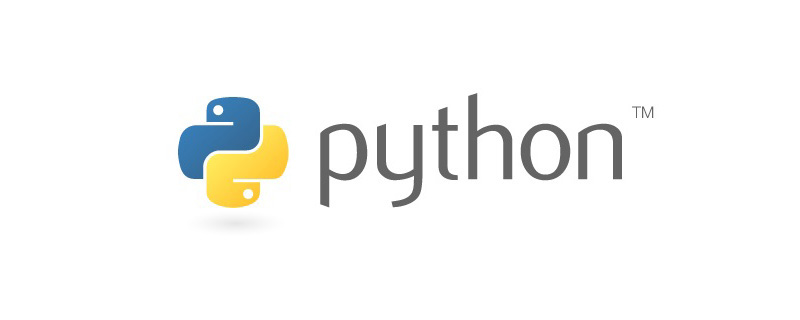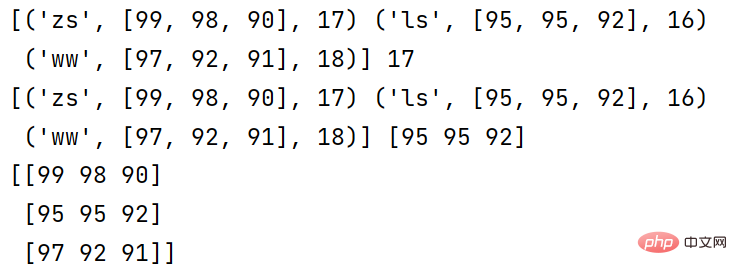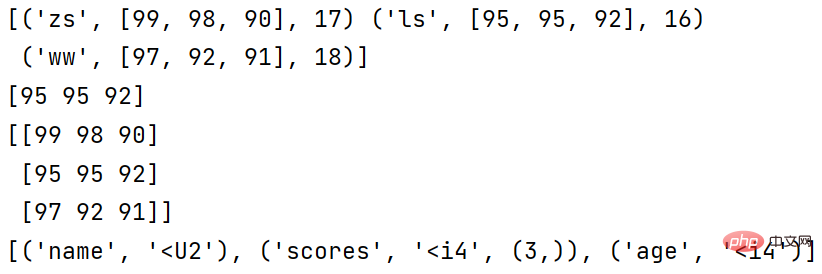Python 데이터 유형 소개 - numpy
이 기사에서는 numpy의 기본 데이터 유형, numpy 사용자 정의 복합 데이터 유형, ndarray를 사용하여 날짜 데이터 유형 저장 등을 포함하여 numpy 데이터 유형과 관련된 문제를 주로 정리하는 Python에 대한 관련 지식을 제공합니다. 아래 내용이 모든 분들께 도움이 되기를 바랍니다.

【관련 추천: Python3 동영상 튜토리얼】
1 numpy의 기본 데이터 유형
| 유형 이름 | 유형 표시기 |
|---|---|
| Boolean | bool |
| 부호 있는 정수형 | int8/int16/int32/int64 |
| 부호 없는 정수형 | uint8/uint16/uint32/uint64 |
| 부동 소수점형 | float 16/float32/flo at64 |
| 복수형 type | complex64 / complex128 |
| 문자 유형 | str, 각 문자는 32비트 유니코드 인코딩 |
import numpy as np
arr = np.array([1, 2, 3])
print(arr, arr.dtype)
arr = arr.astype('int64')
print(arr, arr.dtype)
arr = arr.astype('float32')
print(arr, arr.dtype)
arr = arr.astype('bool')
print(arr, arr.dtype)
arr = arr.astype('str')
print(arr, arr.dtype)2으로 표시됩니다. 원하다 ndarray에 객체 유형을 저장하기 위해 numpy는 튜플을 사용하여 객체의 속성 필드 값을 저장할 것을 권장하며 ndarray에 튜플을 추가하면 이러한 데이터 처리를 용이하게 하는 구문이 제공됩니다.
import numpy as np
data = [
('zs', [99, 98, 90], 17),
('ls', [95, 95, 92], 16),
('ww', [97, 92, 91], 18)
]
# 姓名 2 个字符
# 3 个 int32 类型的成绩
# 1 个 int32 类型的年龄
arr = np.array(data, dtype='2str, 3int32, int32')
print(arr)
print(arr.dtype)
# 可以通过索引访问
print(arr[0], arr[0][2])
데이터의 양이 많은 경우 위의 방법은 데이터 접근에 불편합니다.
ndarray는사전 또는 목록
형식으로 정의할 수 있는 데이터 유형과 열 별칭을 제공합니다. 데이터에 접근할 때 아래 첨자 인덱스나 열 이름을 통해 접근할 수 있습니다.
import numpy as np
data = [
('zs', [99, 98, 90], 17),
('ls', [95, 95, 92], 16),
('ww', [97, 92, 91], 18)]# 采用字典定义列名和元素的数据类型arr = np.array(data, dtype={
# 设置每列的别名
'names': ['name', 'scores', 'age'],
# 设置每列数据元素的数据类型
'formats': ['2str', '3int32', 'int32']})print(arr, arr[0]['age'])# 采用列表定义列名和元素的数据类型arr = np.array(data, dtype=[
# 第一列
('name', 'str', 2),
# 第二列
('scores', 'int32', 3),
# 第三列
('age', 'int32', 1)])print(arr, arr[1]['scores'])# 直接访问数组的一列print(arr['scores'])
3. 날짜 데이터 유형을 저장하려면 ndarray를 사용하세요.
import numpy as np dates = [ '2011', '2011-02', '2011-02-03', '2011-04-01 10:10:10' ] ndates = np.array(dates) print(ndates, ndates.dtype) # 数据类型为日期类型,采用 64 位二进制进行存储,D 表示日期精确到天 ndates = ndates.astype('datetime64[D]') print(ndates, ndates.dtype) # 日期运算 print(ndates[-1] - ndates[0])로그인 후 복사
3. 시간 쓰기 형식2.
1. 날짜 문자열 지원은
2011/11/11을 지원하지 않습니다. 분리 날짜는2011 11 11을 지원하지 않지만,2011-11-11을 지원합니다를 구분하려면 날짜와 시간 사이에 공백이 있어야 합니다. 2011-04-01 10 :10:10
10:10:10numpy는 유형을 제공합니다. 데이터 유형을 더욱 편리하게 처리할 수 있는 문자 코드입니다.
2011/11/11,使用空格进行分隔日期也不支持2011 11 11,支持2011-11-11
2.日期与时间之间需要有空格进行分隔2011-04-01 10:10:10
3.时间的书写格式10:10:104. 유형 문자 코드(데이터 유형 약어)
| 문자 코드 | ||
|---|---|---|
| ? | 부호 있는 정수 유형 | |
| i1/i2/ i4/i8 | 부호 없는 정수 | |
| u1/u2/u4/u8 | 부동 소수점 | |
| f2 4 / f8 | complex64 / complex128 | |
| 문자 유형 | str, 각 문자는 32비트 유니코드 인코딩 | |
| Date | datatime64 | |
5. 필드를 선택하고 ndarray Store 데이터를 사용합니다.
import numpy as np datas = [ (0, '4室1厅', 298.79, 2598, 86951), (1, '3室2厅', 154.62, 1000, 64675), (2, '3室2厅', 177.36, 1200, 67659),]arr = np.array(datas, dtype={ 'names': ['index', 'housetype', 'square', 'totalPrice', 'unitPrice'], 'formats': ['u1', '4U', 'f4', 'i4', 'i4']})print(arr)print(arr.dtype)# 计算 totalPrice 的均值sum_totalPrice = sum(arr['totalPrice'])print(sum_totalPrice/3)로그인 후 복사
【관련 권장 사항:
Python3 비디오 튜토리얼 】
】
위 내용은 Python 데이터 유형 소개 - numpy의 상세 내용입니다. 자세한 내용은 PHP 중국어 웹사이트의 기타 관련 기사를 참조하세요!

핫 AI 도구

Undresser.AI Undress
사실적인 누드 사진을 만들기 위한 AI 기반 앱

AI Clothes Remover
사진에서 옷을 제거하는 온라인 AI 도구입니다.

Undress AI Tool
무료로 이미지를 벗다

Clothoff.io
AI 옷 제거제

Video Face Swap
완전히 무료인 AI 얼굴 교환 도구를 사용하여 모든 비디오의 얼굴을 쉽게 바꾸세요!

인기 기사

뜨거운 도구

메모장++7.3.1
사용하기 쉬운 무료 코드 편집기

SublimeText3 중국어 버전
중국어 버전, 사용하기 매우 쉽습니다.

스튜디오 13.0.1 보내기
강력한 PHP 통합 개발 환경

드림위버 CS6
시각적 웹 개발 도구

SublimeText3 Mac 버전
신 수준의 코드 편집 소프트웨어(SublimeText3)

뜨거운 주제
 7708
7708
 15
15
 1640
1640
 14
14
 1394
1394
 52
52
 1288
1288
 25
25
 1232
1232
 29
29
 PHP와 Python : 다른 패러다임이 설명되었습니다
Apr 18, 2025 am 12:26 AM
PHP와 Python : 다른 패러다임이 설명되었습니다
Apr 18, 2025 am 12:26 AM
PHP는 주로 절차 적 프로그래밍이지만 객체 지향 프로그래밍 (OOP)도 지원합니다. Python은 OOP, 기능 및 절차 프로그래밍을 포함한 다양한 패러다임을 지원합니다. PHP는 웹 개발에 적합하며 Python은 데이터 분석 및 기계 학습과 같은 다양한 응용 프로그램에 적합합니다.
 PHP와 Python 중에서 선택 : 가이드
Apr 18, 2025 am 12:24 AM
PHP와 Python 중에서 선택 : 가이드
Apr 18, 2025 am 12:24 AM
PHP는 웹 개발 및 빠른 프로토 타이핑에 적합하며 Python은 데이터 과학 및 기계 학습에 적합합니다. 1.PHP는 간단한 구문과 함께 동적 웹 개발에 사용되며 빠른 개발에 적합합니다. 2. Python은 간결한 구문을 가지고 있으며 여러 분야에 적합하며 강력한 라이브러리 생태계가 있습니다.
 Python vs. JavaScript : 학습 곡선 및 사용 편의성
Apr 16, 2025 am 12:12 AM
Python vs. JavaScript : 학습 곡선 및 사용 편의성
Apr 16, 2025 am 12:12 AM
Python은 부드러운 학습 곡선과 간결한 구문으로 초보자에게 더 적합합니다. JavaScript는 가파른 학습 곡선과 유연한 구문으로 프론트 엔드 개발에 적합합니다. 1. Python Syntax는 직관적이며 데이터 과학 및 백엔드 개발에 적합합니다. 2. JavaScript는 유연하며 프론트 엔드 및 서버 측 프로그래밍에서 널리 사용됩니다.
 Windows 8에서 코드를 실행할 수 있습니다
Apr 15, 2025 pm 07:24 PM
Windows 8에서 코드를 실행할 수 있습니다
Apr 15, 2025 pm 07:24 PM
VS 코드는 Windows 8에서 실행될 수 있지만 경험은 크지 않을 수 있습니다. 먼저 시스템이 최신 패치로 업데이트되었는지 확인한 다음 시스템 아키텍처와 일치하는 VS 코드 설치 패키지를 다운로드하여 프롬프트대로 설치하십시오. 설치 후 일부 확장은 Windows 8과 호환되지 않을 수 있으며 대체 확장을 찾거나 가상 시스템에서 새로운 Windows 시스템을 사용해야합니다. 필요한 연장을 설치하여 제대로 작동하는지 확인하십시오. Windows 8에서는 VS 코드가 가능하지만 더 나은 개발 경험과 보안을 위해 새로운 Windows 시스템으로 업그레이드하는 것이 좋습니다.
 Python에서 비주얼 스튜디오 코드를 사용할 수 있습니다
Apr 15, 2025 pm 08:18 PM
Python에서 비주얼 스튜디오 코드를 사용할 수 있습니다
Apr 15, 2025 pm 08:18 PM
VS 코드는 파이썬을 작성하는 데 사용될 수 있으며 파이썬 애플리케이션을 개발하기에 이상적인 도구가되는 많은 기능을 제공합니다. 사용자는 다음을 수행 할 수 있습니다. Python 확장 기능을 설치하여 코드 완료, 구문 강조 및 디버깅과 같은 기능을 얻습니다. 디버거를 사용하여 코드를 단계별로 추적하고 오류를 찾아 수정하십시오. 버전 제어를 위해 git을 통합합니다. 코드 서식 도구를 사용하여 코드 일관성을 유지하십시오. 라인 도구를 사용하여 잠재적 인 문제를 미리 발견하십시오.
 PHP와 Python : 그들의 역사에 깊은 다이빙
Apr 18, 2025 am 12:25 AM
PHP와 Python : 그들의 역사에 깊은 다이빙
Apr 18, 2025 am 12:25 AM
PHP는 1994 년에 시작되었으며 Rasmuslerdorf에 의해 개발되었습니다. 원래 웹 사이트 방문자를 추적하는 데 사용되었으며 점차 서버 측 스크립팅 언어로 진화했으며 웹 개발에 널리 사용되었습니다. Python은 1980 년대 후반 Guidovan Rossum에 의해 개발되었으며 1991 년에 처음 출시되었습니다. 코드 가독성과 단순성을 강조하며 과학 컴퓨팅, 데이터 분석 및 기타 분야에 적합합니다.
 터미널 VSCODE에서 프로그램을 실행하는 방법
Apr 15, 2025 pm 06:42 PM
터미널 VSCODE에서 프로그램을 실행하는 방법
Apr 15, 2025 pm 06:42 PM
vs 코드에서는 다음 단계를 통해 터미널에서 프로그램을 실행할 수 있습니다. 코드를 준비하고 통합 터미널을 열어 코드 디렉토리가 터미널 작업 디렉토리와 일치하는지 확인하십시오. 프로그래밍 언어 (예 : Python의 Python Your_file_name.py)에 따라 실행 명령을 선택하여 성공적으로 실행되는지 여부를 확인하고 오류를 해결하십시오. 디버거를 사용하여 디버깅 효율을 향상시킵니다.
 VScode 확장자가 악의적입니까?
Apr 15, 2025 pm 07:57 PM
VScode 확장자가 악의적입니까?
Apr 15, 2025 pm 07:57 PM
VS 코드 확장은 악의적 인 코드 숨기기, 취약성 악용 및 합법적 인 확장으로 자위하는 등 악성 위험을 초래합니다. 악의적 인 확장을 식별하는 방법에는 게시자 확인, 주석 읽기, 코드 확인 및주의해서 설치가 포함됩니다. 보안 조치에는 보안 인식, 좋은 습관, 정기적 인 업데이트 및 바이러스 백신 소프트웨어도 포함됩니다.





 데이터의 양이 많은 경우 위의 방법은 데이터 접근에 불편합니다.
데이터의 양이 많은 경우 위의 방법은 데이터 접근에 불편합니다. 
 1. 날짜 문자열 지원은
1. 날짜 문자열 지원은 
